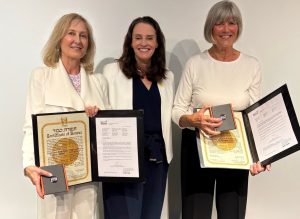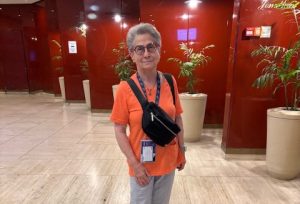All memoirs by Holocaust survivors deserve to be read.
But some are better than others.
And a survivor’s memoir that is accepted by a “name” publishing house is almost always excellent.
So it is with Max Eisen, a force of nature in Toronto’s Jewish community. Even at age 87, Eisen’s memory is a thing to behold. Whether on his rigorous schedule of speaking about his Holocaust experience to school kids, at community events or as a fixture on the annual March of the Living, one can’t help but be amazed at his recall, not only of places and dates, but of smells, sounds, tastes, pains – a full palette of sensory impressions, many of them horrible. And he’s done it unflinchingly.
He was one of three Canadians who testified last year at the trial of former Auschwitz SS sergeant Oskar Groening, and recently at the trial of Reinhold Henning, a former Auschwitz guard.
READ: CANADIAN HOLOCAUST SURVIVORS TESTIFY IN NAZI TRIAL
It comes as no surprise, then, that Eisen’s memoir, By Chance Alone, is a gripping, harrowing read, chock-a-block with pulse-quickening detail.
If there is a trick to this genre, it might be to strike a balance between turning readers off with too much horror, and pulling one’s punch with too little. Eisen is bracingly honest in his telling; while not sparing the reader tales of brutality, deprivation, death and gore, he manages to be cool enough to make one want to turn the page.
In his book, the devil really is in the details, which are plentiful and gruesome, and narrated in a way that is impassioned yet measured.
Eisen’s story begins in the town of Moldava, Czechoslovakia, and a large, Orthodox family that was content and well-off. The extended clan numbered about 60, many living together in a family compound. The author relates a happy early life, with summers spent on a farm.
The war-era chaos came early when, in March 1939, the eastern part of Czechoslovakia was ceded to Hungary and Hungarian fascists took over, bringing with them “an overt ideology of anti-Semitism,” Eisen writes.
By 1940, anti-Jewish edicts banned Jews from owning radios and forbade them from selling alcohol and tobacco, meaning his father was out of work and an income. The next year, all Jewish males between the ages of 18 and 45 – including Eisen’s father and uncle– were shipped to forced labour battalions, including Eisen’s father and uncle. All members of his mother’s family were deported.
The year after that, Eisen, his two brothers, mother and aunt were ordered to pack. After three weeks aboard trucks and trains, the deportation was called off, but the episode served as a taste of things to come.
Jews in Hungarian-speaking regions remained relatively safe until the spring and summer of 1944, when in a span of just eight weeks, some 437,000 of them were deported to Auschwitz, Eisen among them. His descriptions of the three-day cattle-car ride and, on dazed arrival, of blinding floodlights, shouts of “Raus! Schnell!” (Out! Fast!) and prisoners’ striped uniforms aren’t new but they are no less searing.
There’s far worse.
His mother (holding her baby girl), grandparents, aunt and two younger siblings were marched away and gassed. Eisen, his father and uncle were tattooed, given uniforms and taken for slave labour. It happened almost that quickly.
But Eisen does pause for many asides (the barely edible rations, the sickening smell of burning flesh, the dead-eyed prisoners) and to describe one scene readers are not likely to forget. While showering, a young prisoner’s glasses slipped off and he got down on the floor to search for them. “A guard came over and kicked him in the side of the head with his jackboot,” Eisen writes in an almost matter-of-fact way that so jars with the content. “The young man rolled over and the guard stomped on his chest. I could hear the cracking of ribs. The guard, who was now in a frenzy, continued to stomp on the man until he was dead.”
Caught loafing on his work detail one day, Eisen himself was beaten and thrown in a ditch to die with a head injury. Carted back to the camp’s hospital (which existed for guards as well as inmates; Eisen explains why), he received surgery, survived and was appointed the operating room’s cleaner and all around surgical assistant.
He worked 19 hours a day in relative safety and saw more broken bones, spilled guts, flesh-eating disease and bullet wounds than he ever imagined.
A later task involved removing the gold fillings and crowns from the teeth of the recently gassed. Their owners had been alive just a few moments earlier, Eisen pondered. “And now they were just a pile of ash.” He worked there for six months.
READ: DAUGHTER SPOTS HER TEENAGED SURVIVOR MOTHER IN YOUTUBE VIDEO
The reader is reminded of Miklos Nyiszli’s book, Auschwitz: A Doctor’s Eyewitness Account.
Eisen also witnessed the hanging in January, 1945 of four young female prisoners who had smuggled gunpowder into the camp in a successful bid to blow up one of the crematoria. He relates how before being executed one at a time, each spoke the final Hebrew words “chazak v’amatz” (be strong and brave).
There followed a death march to two other concentration camps and finally, liberation, but in such ill health, it spawned words no teen should wonder on his birthday. “I turned 16 years old. Would I make it to 17?”
Eisen’s postwar meanderings took him through Austria, back to his much-changed hometown, to a battle with wet pleurisy and recovery under the wing of a Jewish organization in a Czech town where he lived for three years; a hair-raising escape from newly-communist Prague, a displaced persons camp, and finally, arrival in Canada in 1949 with images from Jack London novels dancing in his head.
Of about 60 members of his extended family, just Eisen and two cousins survived the war.
There is no shortage of stories from survivors. Make sure, though, that this lucid, chilling one is on your list.






